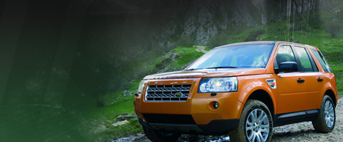Russell Lee
New Member
First post here. Car was making grinding noise and brought to LR dealer for a check up. They said less than 1mm left on rear and 4mm on the fronts. Was quoted $2100+tax for rotor and pads on all 4 corners. No way I am gonna pay that so the DIY project was in order.
Been reading all the threads about changing the pads/rotor on LR3's but hardly seen anything on LR4. Truth be told they are quite similar but still some minor difference here and there I believe. Today just got the read end done and will make another post when the front side completes.
I've ordered the EBC rotors (slotted and dimpled, GD1340/GD1448) and TRW ceramic pads (TPC1479/1099) all from Amazon. Other tools including various sockets, torque wrench, breaker bar, floor jack, and jack stands are necessary.
First I started the car, set the suspension to HIGHEST POSITION as recommended by user manual. Shut down the car, and execute the EPC service mode sequence (power on, brake panel 3x and hold, and press and hold PEC button for 5 seconds). I leave the bonnet and the driver door open through the process. Just in case, i also un-cap the break fluid reservoir to ensure caliper piston can be pressed in smoothly. Gear is set at P and car can be jack up (and choked on the diagonol wheel)
The procedure of removing wheels/caliper are pretty standard (please refer to Bodsys Brake bible). You do need a thin 15mm wrench to hold the retaining pin bolts when remove the 13mm outside bolts. I did not have a thin wrench for the job so i used a 6" long nose vise wrench but I think a Park Tool cone wrench (yes, they are bicycle tools) should do the job better.
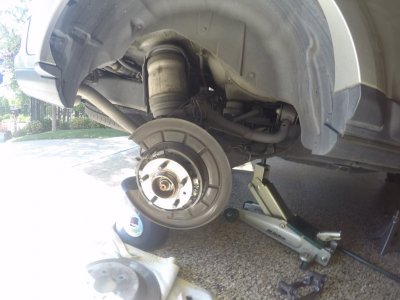
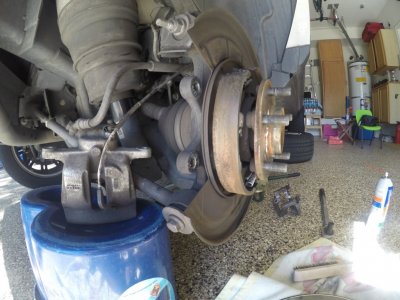
One the caliper is out, you can remove the pads. Mine are almost 100% gone down to the metal plate. Somehow the brake wear sensor was still not triggered (broken?) so i just plug it right back.
Removal of caliper bracket is also straight forward. You do need a breaker bar (I used my 1/2" drive torque wrench which is around 18" long to do the job) as those 15mm 12 points bolts do need around 150NM to loosen up. Once the bracket is out, use the wire brush to get the dirt/metal build-up out especially on the area that the thin metal shims stays. I was lucky that my T50 rotor holding bolt was very easy to come out so no need to use the impact driver. With a few light tap, i can get the rotor out. The California weather really helps to keep things clean. Since the EPB was disengaged, I did not need to do anything on the shoe, lucky me.


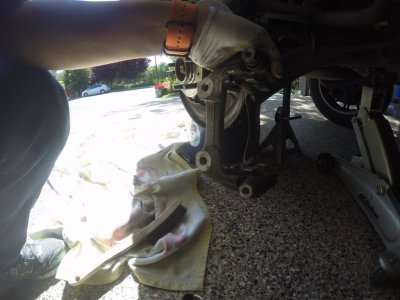

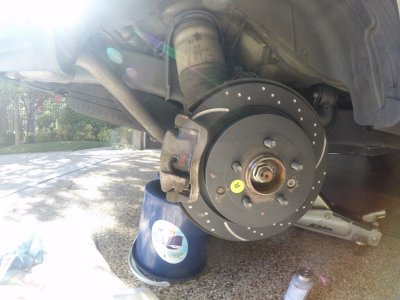
A few points on putting things back. I use copper anti-seize grease on places where metal make contacts. I put some on the hub surface before put on the rotor. T50 Torx was anti-seized. I've also applied the grease when put the new shim on and the contact points to the pads. This will likely help reduce braking squeal and make future removal a lot easier. I also grease the inner caliper bolt (you need to pull it out with the rubber shoe) by using SILICON based grease (since it makes contacts to rubber stuff). The outside bolts has loctite (blue, medium strength) on to make it stay.
Once everything is done, start the car (you need to step on accelerator pedal a few times, and keep it pressed while pressing the brake to get the car started from the service mode). I gave the brake a few deep press so the caliper piston is pushed out to apply pressure on the pads. Lowered the car on regular height and gave it a spin. Everything works fine and I did not try EPB bedding process as everything works fine as is. A real lucky day i guess.
As far as performance goes, I have not noticed much difference in terms of stoping power. May take some miles for the pad/rotor to settle in before full power can be realized. It is a lot quieter than the OE parts for sure as they were squealing quite badly. The black coating on EBC rotor wears out just after a few spin. I guess that's expected as well.
More to come after the front side are done. Feedback/comments welcome.
Been reading all the threads about changing the pads/rotor on LR3's but hardly seen anything on LR4. Truth be told they are quite similar but still some minor difference here and there I believe. Today just got the read end done and will make another post when the front side completes.
I've ordered the EBC rotors (slotted and dimpled, GD1340/GD1448) and TRW ceramic pads (TPC1479/1099) all from Amazon. Other tools including various sockets, torque wrench, breaker bar, floor jack, and jack stands are necessary.
First I started the car, set the suspension to HIGHEST POSITION as recommended by user manual. Shut down the car, and execute the EPC service mode sequence (power on, brake panel 3x and hold, and press and hold PEC button for 5 seconds). I leave the bonnet and the driver door open through the process. Just in case, i also un-cap the break fluid reservoir to ensure caliper piston can be pressed in smoothly. Gear is set at P and car can be jack up (and choked on the diagonol wheel)
The procedure of removing wheels/caliper are pretty standard (please refer to Bodsys Brake bible). You do need a thin 15mm wrench to hold the retaining pin bolts when remove the 13mm outside bolts. I did not have a thin wrench for the job so i used a 6" long nose vise wrench but I think a Park Tool cone wrench (yes, they are bicycle tools) should do the job better.


One the caliper is out, you can remove the pads. Mine are almost 100% gone down to the metal plate. Somehow the brake wear sensor was still not triggered (broken?) so i just plug it right back.
Removal of caliper bracket is also straight forward. You do need a breaker bar (I used my 1/2" drive torque wrench which is around 18" long to do the job) as those 15mm 12 points bolts do need around 150NM to loosen up. Once the bracket is out, use the wire brush to get the dirt/metal build-up out especially on the area that the thin metal shims stays. I was lucky that my T50 rotor holding bolt was very easy to come out so no need to use the impact driver. With a few light tap, i can get the rotor out. The California weather really helps to keep things clean. Since the EPB was disengaged, I did not need to do anything on the shoe, lucky me.





A few points on putting things back. I use copper anti-seize grease on places where metal make contacts. I put some on the hub surface before put on the rotor. T50 Torx was anti-seized. I've also applied the grease when put the new shim on and the contact points to the pads. This will likely help reduce braking squeal and make future removal a lot easier. I also grease the inner caliper bolt (you need to pull it out with the rubber shoe) by using SILICON based grease (since it makes contacts to rubber stuff). The outside bolts has loctite (blue, medium strength) on to make it stay.
Once everything is done, start the car (you need to step on accelerator pedal a few times, and keep it pressed while pressing the brake to get the car started from the service mode). I gave the brake a few deep press so the caliper piston is pushed out to apply pressure on the pads. Lowered the car on regular height and gave it a spin. Everything works fine and I did not try EPB bedding process as everything works fine as is. A real lucky day i guess.
As far as performance goes, I have not noticed much difference in terms of stoping power. May take some miles for the pad/rotor to settle in before full power can be realized. It is a lot quieter than the OE parts for sure as they were squealing quite badly. The black coating on EBC rotor wears out just after a few spin. I guess that's expected as well.
More to come after the front side are done. Feedback/comments welcome.

